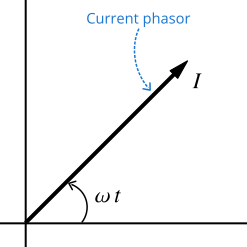Alternating current has alternating source of emf. If you rotate a conducting loop in a magnetic field, the alternating emf is induced in the loop resulting the alternating current or simply ac current. Since the emf induced changes sinusoidally, the current is also sinusoidal.
It's easier to express these sinusoidal quantities in terms of phasor for further analysis. A phasor is a simple arrow that rotates about a fixed point in anticlockwise direction in a cartesian plane whose length is equal to the maximum value of the sinusoidally changing quantity (amplitude) and its projection on an axis determines the instantaneous value the quantity. Note that phasor is not a physical quantity, but instead it is a simple geometrical entity.
The Figure 1 shows a simple phasor representing current rotating in anticlockwise direction.

A phasor has a direction and its length is equal to the amplitude of the sinusoidally varying quantity. And here we use these phasors to represent sinusoidally changing voltage and current and their phase relationship determined by the angle between the current and voltage phasors. You can simply consider a phasor as a rotating vector in anticlockwise direction. In determining impedance, you'll see we add voltages in terms of phasors vectorically.

Effect of resistor in AC circuit
What's the effect of resistor in AC circuit? The answer is rms current and voltage.
A resistor of resistance \(R\) is connected with alternating current source which is shown in Figure 2 above. Since the emf is changing sinusoidally, the current also changes sinusoidally. The expression of sinusoidally changing current is given by
\[i = I\sin(\omega\,t)\]
where \(i\) is the current at any instant and \(I\) is the maximum current (current amplitude). The instantaneous voltage is \(v = iR\).
\[v = IR\sin(\omega\,t) = V\sin(\omega\,t)\]
The current I is the maximum current in the cycle and \(V=IR\) is the maximum voltage. Notice that, here we are using lowercase letters for changing quantities such as \(i\) for current and \(v\) for voltage, and uppercase letters for values that don't change (amplitudes). The Figure 3 below shows the curves of both voltage and current.

Notice that, voltage and current are in phase, that is their maximum, minimum and zero values occur at the same time. The Figure 4 shows the phasor diagram showing both phasors representing current and voltage, and shows that they are in phase. And the projection of the phasors is the instantaneous value of current or voltage.

Here the direction of current is changing, but it has no effect on the energy delivered to the resistance, that is \(i^2R\). The energy that's delivered to the resistance is due to the collisions of charges with the ions and therefore, independent of the direction. And the term contains the square of instantaneous current and therefore, valid for both direct and alternating current cases.
However, the energy due to the maximum current \(I\) in alternating current is different from the energy due to the same magnitude of direct current. That's because, in alternating current the maximum current only occurs for an instant. So, we determine the term called rms current to describe the average of sinusoidally changing current.
The rms value is the root-mean-square value of a quantity where we take the square root of mean (average) of square of the quantity. So in rms current, we take square root of the average of \(i^2\). Since it contains the square of \(i\), the sign of current does not matter. Note that the average of sinusoidally changing current is zero, that is average of \(\sin(\omega\,t)\) is zero, so the rms value is used instead, where we don't need to worry about the sign of current.
The square of current is \(i^2 = I^2\sin^2(\omega\,t)\). The average of \(\sin^2(\omega\,t)\) is \(1/2\) and, therefore, \((i^2)_{\text{avg}} = I^2/2\). Now take the square root of the average and you'll get rms current, that is \(I_\text{rms} = I/\sqrt{2}\). So, \(I =\sqrt{2} \, I_\text{rms}\). Similarly, the rms voltage is \(V_\text{rms} = V/\sqrt{2}\) and \(V = \sqrt{2}\,V_{\text{rms}}\). The meters to read current and voltage are mostly calibrated to read the rms values. So, if the voltmeter reads the voltage to be \(120 \text{V}\), the maximum voltage for that case is \(V = \sqrt{2}\,(120) = 170 \text{V}\).
The rms value for alternating current is equivalent to the direct current, that is if the alternating current has rms value of \(2\text{A}\), it is equivalent to the direct current of \(2\text{A}\). It means we can still use the same formula for alternating and direct currents, for example the rate of energy transferred to a resistance (power input) is \(I^2R\) where \(I\) is the rms value for current if it is alternating current. So, rms value is used for alternating voltages and currents to make the power calculations easy equivalent to their dc counterparts.





